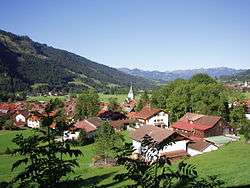Bad Hindelang
| Bad Hindelang | ||
|---|---|---|
|
Bad Hindelang | ||
| ||
 Bad Hindelang | ||
Location of Bad Hindelang within Oberallgäu district  | ||
| Coordinates: 47°30′19″N 10°22′10″E / 47.50528°N 10.36944°ECoordinates: 47°30′19″N 10°22′10″E / 47.50528°N 10.36944°E | ||
| Country | Germany | |
| State | Bavaria | |
| Admin. region | Schwaben | |
| District | Oberallgäu | |
| Government | ||
| • Mayor | Roman Haug | |
| Area | ||
| • Total | 137.02 km2 (52.90 sq mi) | |
| Elevation | 825 m (2,707 ft) | |
| Population (2015-12-31)[1] | ||
| • Total | 5,033 | |
| • Density | 37/km2 (95/sq mi) | |
| Time zone | CET/CEST (UTC+1/+2) | |
| Postal codes | 87541 | |
| Dialling codes | 08324 | |
| Vehicle registration | OA | |
Bad Hindelang is a municipality in the district of Oberallgäu in Bavaria in Germany. As of 2008 it has a population of 4,915. Its sulphur spring was used for cures in the 19th century and today the municipality is a major health resort.[2]
Geography
The main town of Bad Hindelang lies at an altitude of 825 metres above sea level. The municipality includes the following areas, Bad Hindelang, Vorderhindelang, Bad Oberdorf, Hinterstein, Oberjoch and Unterjoch.
Landscape
The town hall is a former hunting lodge, built in 1660 by Prince Bishop of Augsburg, Sigismund Franz, Archduke of Tyrol.[3] It was used as a summer residence by the prince bishops of Augsburg until 1805. After the secularization of the palace went over to the state, it then fell into private ownership as a guest house and schoolhouse, until it finally became the town hall of the municipality. It still has an early baroque rococo fireplace.
The church of St. Jodokus in Bad Oberdorf was built in 1937-38 by Thomas Wechs to replace the old church but the present church contains several valuable pieces including a 1493 Byzantine style depiction of Madonna and Child and a 1519 carving on the altar by Jörg Lederer.[4] There is a gothic life-size depiction of Christ on a donkey on Palm Sunday. Other panel paintings and statues of saints complete the facilities of the church.
The Evangelical Church [5] is located on the banks of the Ostrach River and was established in 1628. The first wooden chapel was dedicated to St. Michael, but was destroyed by a storm on 18 January 1739. In 1748, a stone building was subsequently completed. On 30 October 1748 it was consecrated the chapel as Trinity Chapel. The altar of Jörg Lederer was one located in this chapel but was moved to St. Jodokus church in 1937.
Bad Oberdorf contains the Friedenshistorisches Museum[6] and the Hinterstein Carriage Museum which has numerous displays related to carriages and wax models.[7] It also contains the Upper Mill estate which dates back to 1433 and is now run as a museum and hotel. It contains a number of items related to Bad Hindelang's cultural heritage and old costumes of the millers etc. Also of note is the Dreikugelhaus in Bad Hindelang, built in 1671. The original owner was the salt merchant Thomas Scholl.

Mayors
- 1900-1919: Josef Anton Blanz
- 1920-1933: Michael Haas
- 1933-1939: Anton Schmid
- 1939-1945: Karl Blanz
- 1945-1947: Max Zillibiller, CSU
- 1947-1948: Xaver Blenk
- 1948-1960: Alois Haug
- 1960-1984: Georg Scholl, CSU
- 1984-2008: Roman Haug, Freie Wähler
- 2008–present: Adalbert Martin, CSU
Notable people
- Franz Xaver Eberhard (1767–1836)
- Richard Mahn (born 1866 in Leipzig, died 1951 in Hindelang)
- Fritz von Kamptz (born 16 February 1866 in Glogau, died 15 February 1938 in Hindelang)
- Charley Peklo (born 23 August 1880 in Taus, died 6 November 1959 in Immenstadt),
- Walter Jacob (born 21 October 1893 in Altenburg/Thüringen, died 13 July 1964 in Hindelang)
- Sepp Rist (1900–1980)
- Maria Antonie (Toni) Gaßner-Wechs (1900–1956)
- Maria Blanz (1912–1995)
- Christian Modersohn (born 13 October 1916)
- Kilian Lipp (born 1953 in Ortsteil Vorderhindelang)
- Willi Tannheimer (born 1940 im Ortsteil Hinterstein)
- Hubert Blanz (born 21 February 1969)
- Christoph Finkel (born 1971),
- Aurélie Blanz (born 1973)
- Ulrich Lipp (born 10 August 1957 in Vorderhindelang)
- Karl Hafner (1894–1971)
- Michael Bredl (1916–1999)
- Clemens Wenzeslaus (1739–1812)
- Pamela Behr, (born 1956)
- Philipp Neri Chrismann (born 1751 in Hindelang, died 1810 in Hedingen bei Sigmaringen),
- Luitpold von Bayern (1821–1912)
- Thomas Wechs (1893–1970)
- Hans-Peter Lanig
- Anton Morent (1924–2006)
- Horst Zuse (born 1945)
Photo gallery
 Town hall
Town hall Church of St. Jodokus
Church of St. Jodokus Evangelical church
Evangelical church Hinterstein Carriage Museum
Hinterstein Carriage Museum Konrad Zuse's computer Z4 was hidden in a shed of this (former) Steinadler inn in March 1945
Konrad Zuse's computer Z4 was hidden in a shed of this (former) Steinadler inn in March 1945 Catholic church St. John the Baptist
Catholic church St. John the Baptist Gefallenen-Gedenkkapelle
Gefallenen-Gedenkkapelle Kapelle in Bruck
Kapelle in Bruck Hammerschmiede in Bad Hindelang
Hammerschmiede in Bad Hindelang Gasthof Adler-Post
Gasthof Adler-Post Hotel Sonne
Hotel Sonne
Literature
- Wolfgang B. Kleiner/Martin Kluger (Augsburg): Bad Hindelang im Allgäu. Bayerns zauberhafter Süden. context medien und verlag, Augsburg 2009, ISBN 978-3-939645-21-4
References
- ↑ "Fortschreibung des Bevölkerungsstandes". Bayerisches Landesamt für Statistik und Datenverarbeitung (in German). June 2016.
- ↑ www.bad-hindelang.info
- ↑ www.bad-hindelang.info Aktuelle Informationen ueber Bad Hindelang
- ↑ Alfons Kasper, Art Walks from the upper reaches to Ostallgäu, Bad Schussenried 1969, p. 173-180
- ↑ www.e-kirche.de
- ↑ Friedenshistorisches Museum
- ↑ Hinterstein Carriage Museum documentary
External links
| Wikimedia Commons has media related to Bad Hindelang. |

